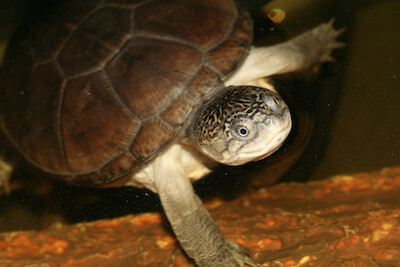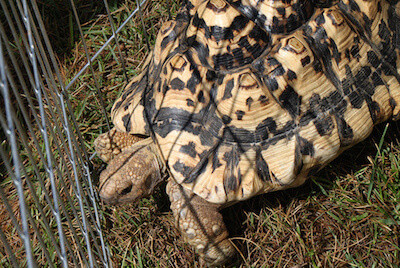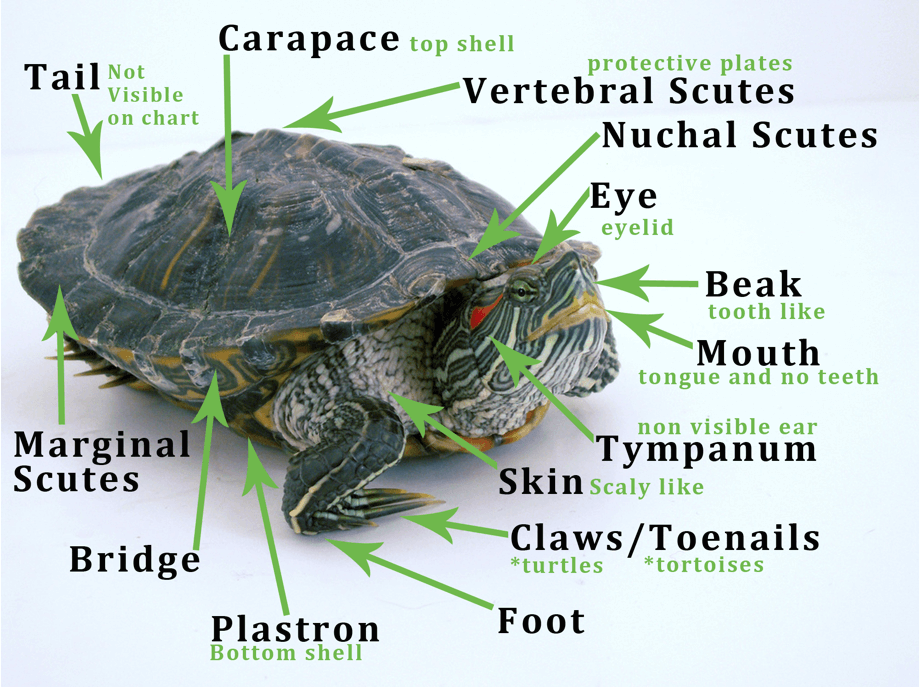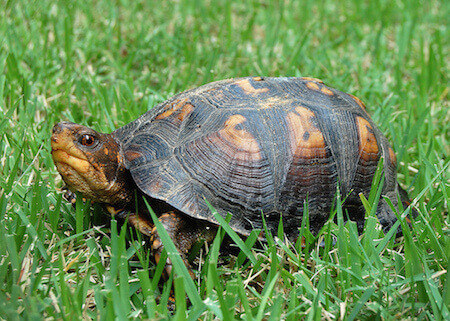Comparing Types of Turtles and Tortoises
Turtles and tortoises belong to the class, reptile (Reptilia). Reptiles can be described as cold-blooded (Ectothermic: metabolism that is controled by the surrounding environment) animals that have scales or scutes on their skin, lay shelled eggs, breathe air tetrapods (having four legs or descended from four legs). Turtles and tortoises then get grouped into Testudines, and again into one of 14 families. All tortoises are grouped into the Testudinidae family while the other turtles like: pond, musk, softshell, snapping, sidenecked, sea, and box turtles are classified into one of the other 13 families.
The term Chelonians is often used when describing all turtles and tortoises as to not leave any of the 300 or so turtle and tortoise species out, or, when the species in question is not known. It’s a catch-all word.
- Herp: short for the word Herpetology; the study of reptiles and amphibians.
- Chelonians: reptiles that include turtles and tortoises. The term comes from Greek word Chelone, meaning: home on back.
Types of Turtles and Tortoises
For a complete breakdown and description of the types of turtles and tortoises, start here:
Turtle Classification
- Pelomedusidae
- Pelomedusa
- Pelusios
- Erymnochelys
- Podocnemis
- Peltocephalus
- Chelidae
- Chelodina
- Elseya
- Emydura
- Psedoemydura
- Rheodytes
- Phrynops
- Hydromedusa
- Chelus
- Platemys
- Podocnemididae
- Erymnochelys
- Peltocephalus
- Podocnemis
- Dermatemydidae
- Dermatemys mawaii (C. American River Turtle)
- Carettochelyidae
- Carettochelys insculpta (Pig-Nosed)
- Platysternidae
- Platysternidae megacephalum (Big-Headed)
- Dermachelyidae
- Dermochelys coriacea(Leatherback)
- Chelydriade
- Chelydra serpentina (Snapping)
- Macroclemys temminckii (Aligator Snapping)
- Cheloniidae
- Chelonia (Green/Flatback)
- Lepidochelys (Ridley)
- Caretta (Loggerhead)
- Eretmochelys (Hawksbill)
- Kinosternidae
- About 12 Mud Turtles
- About 12 Musk Turtles
- Geomydiade
- About 70 Pond & River Turtles
- Trionychidae
- About 24 Soft Shelled Turtles
- Testudinidae
- About 50 Tortoises
- Emydidae
- About 90 Aquatic Turtles
What is the Difference between a Turtle and a Tortoise?
Furthermore, more confusion arises when we humans can’t seem to agree on what is what in regards to terminology. Tortoises can easily be grouped in with turtles. A good example is the Box turtle. In America, that is what they are called, but in Europe, they are referred to as Box Tortoises.
In general, the best way to determine if it’s a turtle or a tortoise you are trying to identify is to know a few rules that apply to the majority of their respective families. Turtles need water to survive. When we say water, we mean they need water for more than just drinking; turtles are aquatic or semi-aquatic. This means that turtles live in and out of water. The exception is the box turtle, who have thicker skin that retains water like tortoises. Tortoises are terrestrial animals, meaning they live on land and don’t require water (aside from drinking) to survive. The exception to this is the Hingeback tortoise who needs a high humidity environment to survive.
Turtle Characteristics


Not ever turtle will fit this description but the main characteristics that show that a chelonian is a turtle and not a tortoise include the following below. (Some exceptions include the many number of box turtle species)
- Live in and out of water
- Feet have claws more so than toenails
- Might have webbed like feet or flippers
- Tend to have lower pitched shells
- Might lack a plastron
- Might lack scutes (soft shelled)
Tortoise Characteristics


Again, there are a few exceptions but the following are the traits that describe the characteristics that most tortoises will have and turtles will not. ( A few exception: hingebacks need water; pancake tortoises have a flat like shell)
- Live exclusively on land
- Have thicker skin that helps retain water
- Feet have toenails more so than claws
- Tend to have higher pitched shells
See the anatomy graphic below to understand the parts of a turtle or tortoise.


Turtle Anatomy
Shell
A turtle shell provides shelter and protection from predators and threats. The shell consists of two parts or several bones fused together; the top part called the carapace and the underside called the plastron. The top section is connected to the turtle’s vertebra and the plastron is connected by the rib cage. The two parts are connected to each other by what is called the bridge.
Some tortoise and turtle species have shells that are hinged; meaning they have the ability to close up. Typically the hinge is on the front half of the plastron but the hinge tortoise has a hinge on the back half of the carapace. In addition to hinges on a shell, there are characteristics of a shell that can help you determine the sex of the chelonian. A flat plastron can mean its a female, while a concave one can mean it’s a male.
Unlike a hermit crab, turtles and tortoises can not leave their shells, they are connected to them for life. When a hermit crab grows, it needs to leave its shell and upgrade to a larger one. Turtle shells on the other hand grow with the turtle. Occasionally a shell won’t grow at the same rate as the turtle and this can lead to a disfigured turtle. In captivity, theses odd balls can still go on to live a happy life.
Scutes
Scutes are protective plates that cover the shell of a turtle or tortoise. They consist of the same material that makeup finger nails, keratin. The top section of scutes are called the vertebral scutes; the outer most ones are called the marginal scutes and the ones right above the head are called the nuchal scutes. Some species lack the nuchal scutes while some have no scutes what so ever. These species of turtles that lack these protective shields on their shells are called soft shelled turtles, which is a flexible and leathery shell.
Skin
As stated previously, aquatic water turtles have softer skin that requires an external water sources to stay hydrated. Without water, the skin will dry up and create turtle health problems. A tortoise’s skin is thicker and is designed to help retain water.
The skin of a turtle looks scaly similar to their reptile cousins and like other reptiles, all tortoises and turtles shed their skin. The skin tends to come off in patches; so if you observe patches of skin falling off or floating in the water, don’t be alarmed, this is perfectly normal.
Feet/Flippers
The feet of turtles and tortoises make telling the difference between the them a bit easier. Aquatic water turtles will either have webbed feet or even flippers in the case of sea turtles. These flippers and webbed feet make it easier for them to swim through the water. Even though their feet look more for swimming, they still have claws to some extent. These claws help the female turtles dig breeding nests. Some males turtle species have longer claws to help hold their mates while breeding.
Box turtles and tortoises have thick rough looking skin on their feet. These turtles have short stumpy feet that keep them low to the ground. Larger tortoise species on the other can have bigger feet that can look like tiny elephant feet, which of course are still pretty big. Instead of claws, these tortoises have toe nails which meant for digging.
Neck
Turtle necks come in a range of lengths. Some species have necks long enough to get them named snake necked turtles. A longer neck on a turtle allows it to reach up out of the water to breathe and also to grab a bit to eat as it swims by. A Long neck on a tortoise on the other hand allows it to reach up and grab leaves on taller shrubs. This physical feature can become a necessity in geographic locations that have scarce vegetation.
There are two types of necks found on turtles and tortoises. The first type of neck is one that moves vertically and might also be able to retract into the shell given the turtle is a species that has that ability. This type of chelonian fits into the Cryptodira division. The other type of neck moves side to side. Instead of tucking in their heads in, they tuck them around the sides of their shells. These turtle types fit into the Pleurodia division.
Beak/Mouth
Like birds, turtles and tortoises have beaks too. The reason they are equipped with beaks are because they lack teeth. A beak acts as a tooth that helps a turtle rip and chew its food; wether that be green vegetation or a grub or bug.
Even with no teeth, a bite from a turtle can be painful. You might get a strong pinch from a box turtle that bites but if you were unfortunate enough to get a bite from a snapping turtle, you could lose a finger. If you find yourself with a finger trapped in the mouth of a turtle, submerge the chelonian under water; it will let go either because you caught it off guard or because it needs to breathe.
Eyes
The eyesight of a turtle is as good if not better than that of a human being. It’s thought they see best at far distances and less so up near. They can also see in color; mainly in the red spectrum of light. Having good eyesight helps them avoid predators and threats as well as spot their own species.
Sea turtles, snapping turtles and most aquatic species can see very well underwater, as well as we can see on land. It’s said that these turtle types might have the opposite effect being able to see in and out of water. Their eyesight on land can best be described as what we humans see like when we open our eyes under water.
Ears
While Chelonians don’t have outer ears, some have ear openings that lead to the inner ear. Turtles and tortoises have even less than that. What they have is called a tympanum which acts as its hearing organ. For this reason, they hear low frequency sounds; meaning, turtles don’t hear well. The extent of their hearing deals more so with vibrations than actual sounds.


Photos by: ryonedwards, cheloran, mr_t_in_dc, labyrinthx


Reviewed By: Tim Winter


Tim Winter has a strong affection for pets and wildlife. His years of experience caring for various types of pets has led him to share his knowledge with others on the best practices in pet care. Tim holds a Bachelor of Science from the University of Oregon School of Journalism and Communications.

What type of tortoise which has a yellow bridge and the other parts of its body is black?
I have a tortoise I rescued from a teacher who had it in his jr. high school class. I have had him for about twenty years now but do not know exactally what type of tortoise he is or even if he is a he. He has some of the characteristics of a desert tortoise but he’s small. He’s inactive in winter and wakes up around February or March and is active throuout the summer. Does not swim but will climb into his water dish to soak from time to time. He has toe nails on his front and back feet. Likes to hide in or under things. If I send a photo could you help me identify him (or her)? Thanks
Use our contact form to send a request for that. we will reply and you can send the photos to that address
What form are u talking about? I have a turtle that I have had for a few years and I have no idea what he/she. I would love for someone to tell me what it is.
You can send an email through the contact page. I’ll respond and then you can send photos.
What is an green rivier tortoise????
hi i got a pregnant turtle near our river. i live in Trinidad and Tobago and i think the turtle is a mud turtle because it was very muddy and i washed it with a hose. presently it s not moving much and i need to know if to keep it in an aquarium or in sand and have a container of water nearby?
You should really let the turtle go. wild turtle can contain diseases and things like salmonella. Also if she really is pregnant, she and her eggs will do better if they are not held in captivity. If you want a turtle as a pet, you should buy one from a reputable breeder. You will also know what type it is which will help in caring for it properly.
It is red ear slider turtel not a tortoise
Please tell me what it eats and how much time it shall stay in water
Follow this post on what do aquatic turtles eat?
Well I bought a tortoise by mistake the seller told it is a sea turtel but in fact it hates staying in the water and it doesn’t want to eat now. ..the man gave me “white rose :turtel fish foods to be put in the water….actually I hate this feeling I can’t understand what it really needs
It has that orange lines on the neck …so I hot it is a tortoise
What shall I do
Please send us an email through our contact form and then we can have you send us a photo. We might be able to help tell you what type of turtle you really have.
I have a Star Tortoise and its skin is started to split. Can I know why has this happen? Please reply ASAP as I m bit worried
You should take your tortoise to the vet. They can diagnose the issue and hopefully provide treatment.
Well i have a turtle or a tortoise. Was given to me. He use to have a healthy appetite but now not so much. I would like to know what he is and why hes not eating.
Entice eating by adding some color to the food. Mix in some strawberries or other types of tasty foods. See this post on feeding a picky eater
Someone had drop a tortoise off in my yard I have no clue what type it has ripples all around the shell, a few years ago I was babysitting a box turtle in which they never came back for, I learned that they hybirnated do tortoises do the same, Will the box turtle get along with the tortoise. I have a lot of questions but I start with these, thank you
it depends on what type of tortoise it is and if it is native to your area. Some tortoises hibernate but only if they are from colder climates. if it is a native species, perhaps it just wandered into your yard. in that case, let it go free. This new tortoise might have a disease so it might be best to quarantine it from the box turtle. Additionally the tortoise and box turtle might not be compatible and a fight may occur. Sure there are always exception and if you have a large enough space, it is possible they would be fine but still not really recommended.
i don’t whether greenie is a turtle or a tortoise. i also need to know its gender. it is small and how do i find out my answers?
If you tell me what it looks like, I might be able to help answer that. Where did you get it from? This too might make it easier to answer what type it is.